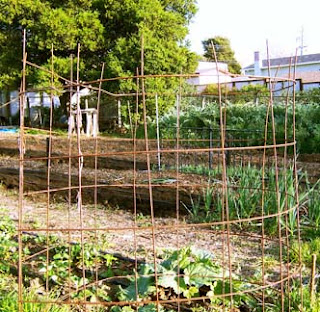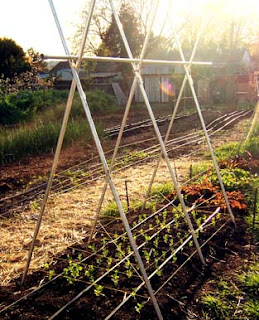1. Trellises – Tom works for an electrical supply company. They usually end up throwing out all sorts of items that are damaged, including dented 1/2″ conduit pipe. It’s galvanized to keep it from rusting and it makes great stakes and tepee type trellises. We use nylon contractor’s string to keep it together because it doesn’t break down like twine and you can use it year after year. Get in contact with a local electrical company and see if they are willing to give you their bent or dented conduit. You can also use PVC irrigation pipe, but if it’s white, just realize that it will eventually break down with UV exposure (ending up in the landfill) and that it should NEVER be burned (it releases dioxin, a highly toxic compound). We also use old metal railings that a friend took off of their porch to replace.
 |
| Concrete Reinforcing Mesh Tomato Cage |
3. Compost Bin – Have you ever been flabbergasted by the price of those black compost bins? $75-150 for a box of black plastic. Well, you don’t need something that fancy. Go to a warehouse and ask them if you can have their old pallets. These work great. Just stand them up, lash or nail them together and viola! You’ve got a compost bin that allows plenty of airflow. Now, they don’t last too long because the wood will eventually rot, however, it’s free and you can easily replace it. For us though, we create too much compostable waste. We had two of those bins and filled them both within a couple of months. Not to mention we keep forgetting to turn them. So now we let our chickens do it. We just pile everything into their run and as it breaks down it gets lots of bugs and worms that the chickens scratch for, turning the pile. It’s a win-win. They do all the work while they get all the goodies.
 |
|
| Plant tags made from popcicle sticks in reused pots |
6. Mulch – Mulch is expensive. It usually runs about $25-27/cubic yard. When you have a large area that can just be too much. We used straw for a long time, but it breaks down too fast and can sometimes have a lot of seeds in it. So now we call our local tree service. They dump whatever they have on hand in our driveway and we move it to where we need. It’s completely free and it keeps it from going to the dump – saving the tree service money. It’s a win-win for both sides.
7. Compost – Bagged compost is ridiculously expensive. Our city takes yard refuse and then composts it. We used to then make a trip to the dump and get our truck bed filled with compost for a whopping $3.81. Check out your local refuse company and see if they have a similar program. If they don’t let them know that they should. They won’t do it if they don’t think there is a demand for it. Nowadays our chickens, goats and rabbits give us all the compost and manure we need.
8. Garden Cloche – Little greenhouses for your individual transplants when the night temperatures are still a bit chilly. The traditional ones are made of glass and can be very pricey. The cheap version is plastic milk gallon jugs. Cut the bottoms off and just place over the plant. Remove the cap in the morning to allow air flow and to avoid overheating during the day. Replace the cap in the evening. If where you live is breezy you can use a straightened out coat hanger (but leave the hook end) and stick it into the ground through the center of the jug (avoiding the plant below) and have the hook part go over the lip of the jug to help hold it down. The downside though is you won’t be able to use the lid. Another option is to use the hook end on the handle of the jug, but it’s not as good at keep the jug in place.



When I have my own home with land around that big home. I will plant my own garden of vegatables. Can't wait!!
I like your frugal ideas, I've had a compost bin made out of pallets and I use Popsicle sticks as markers. I also get mulch and wood chips from our dump for free. If I knew how to post a picture, I'd post one of the planter I use for my pepper plants. It's an old Coke cooler that was found behind my brother's house. Some people may gasp at the thought of keeping outside, but it wasn't in that great of shape to put in our house, plus it's too big. It makes a perfect planter. And, I've turned our old gas grill into a potting bench.
Bonnie
(sorry if i double commented/not sure if the first one went through)
this is one of my new favorite posts – i love the innovative, cheap, re-engineering of easily found industrial strength stuff.
i hate my tomato cages – and the tomatoes never want to cooperate with the right shape.
thanks for putting this together – i did buy some big black plastic bins to get started, but this is the kind of stuff that inspires me.
Great tips! Visiting from Backyard Farmer.
Instead of recyling the plastic seed pots, this year I made oragami bio-degradable pots with brown paper bags from the grocery store. One bag makes 16 small pots. They are really easy to fold up and are awesome in a pinch. When the seedlings were big enough, I just tore off the bottom and planted the whole thing – confident that the earth and my plant was better for it. thinghttp://www.youtube.com/watch?v=rNBHYrv4-Gw
I also used the little pastic tubs my grandkids dyed Easter eggs in. I turned them over, heated up my glue gun and poked the hot tip into the bottom to make some holes. Easy! These made perfect gifts to my garden buddies.
Off to the hardware store now to find concrete reinforcement mesh! Great idea! I hate those cheap and flimsy tomato cages. This year we made some self-watering planters with 5 gallon buckets a yogurt container and PVC pipe. I’m going to plant tomatoes in them and was agonizing about how to contain them vertically. A tube of mesh jammed into the bucket befoer I fill it with dirt should be just the ticket!